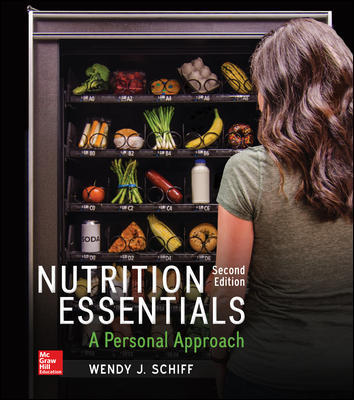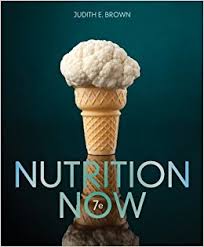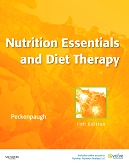Test Bank Nutrition Essentials A Personal Approach 2nd Edition By Wendy Schiff
Original price was: $110.00.$45.00Current price is: $45.00.
Test Bank Nutrition Essentials A Personal Approach 2nd Edition By Wendy Schiff is a great resource for anyone who wants to learn more about nutrition. The book provides an overview of the different nutrients that are essential for good health, and it offers practical advice on how to get the most out of your diet.
The book also includes a section on how to create a healthy eating plan, and it offers tips on how to make sure that you’re getting all of the nutrients that you need. If you’re looking for a comprehensive guide to nutrition, then Test Bank Nutrition Essentials A Personal Approach 2nd Edition By Wendy Schiff is the book for you.
Digital item No Waiting Time Instant Download
ISBN10: 1259706540, ISBN13: 9781259706547
Description
Test Bank Nutrition Essentials A Personal Approach 2nd Edition By Wendy Schiff
Unit 03
|
1. |
A nutrient requirement is A. the recommended daily intake of a nutrient. B. the smallest amount of a nutrient that maintains a defined level of nutritional health. C. an amount of a nutrient that ensures optimal nutritional status. D. an amount of a nutrient that includes a “margin of safety.” |
|
2. |
Kevin was a participant in a clinical study to determine how much niacin cures pellagra, the niacin deficiency disease. During the study, he consumed only a formula diet that was deficient in niacin. After developing pellagra, he was given 2 mg of niacin a day for 2 weeks, but he still suffered from the disease, so the scientists added 2 mg of the vitamin to Kevin’s formula. By the beginning of the 5th week of the study, the researchers noticed that Kevin’s signs and symptoms were greatly improved. At the end of the 5th week, he was feeling fine. The researchers concluded that A. Kevin’s niacin requirement was about 4 mg a day. B. Kevin’s daily value for niacin was 4 mg a day. C. the AI for niacin should be 4 mg plus 60 mg as a margin of safety. D. the RDA for niacin should be 4 mg. |
|
3. |
Ramon was a participant in a clinical study to determine how much vitamin D is required by healthy humans. During the study, Ramon consumed only a formula diet that was nutritionally complete, except it did not contain vitamin D. Within a few weeks, he developed signs and symptoms of vitamin D deficiency. At that point, researchers gave 5 mcg vitamin D to Ramon each day for a week, but his signs and symptoms of the deficiency remained. The next week, the scientists added 5 mcg vitamin D to his diet, so that his formula contained 10 mcg of the vitamin. By the end of that week, Ramon reported feeling much better. Based on this information, the researchers concluded that Ramon’s A. RDA for vitamin D was 5 mcg, plus a margin of safety amount of 5 mcg. B. AMDR for vitamin D was between 5 and 10 mcg. C. daily required allowance for vitamin D was about 10 mcg. D. requirement for vitamin D was 10 mcg. |
|
4. |
Kayla was a participant in a clinical study to determine how much vitamin C cures scurvy, the vitamin’s deficiency disease. During the study, Kayla consumed only a formula diet that was nutritionally complete, except it didn’t contain vitamin C. Within a few weeks, Kayla developed scurvy. At that point, researchers gave 2 mg vitamin C to Kayla each day for a week, but her signs and symptoms of scurvy remained. In the weeks that followed, the scientists continued to increase Kayla’s intake of the vitamin by 2 mg/week. After a week of taking 10 mg of vitamin C/day, Kayla reported feeling much better. Based on this information, the researchers concluded that Kayla’s A. requirement for vitamin C was 10 mg. B. EER for vitamin C was about 10 mg. C. RDA for vitamin C was 10 mg, plus 15 mg as a margin of safety. D. AI for vitamin C was 100 mg, which was 10 times the amount that cured her case of scurvy. |
|
5. |
A group of 50 adult male humans were in a clinical study to determine how much niacin is toxic. During the first two weeks of the study, members of the group consumed only a formula diet that was nutritionally complete, except it contained 24 mg niacin, which is 1.5 times the RDA for niacin (males). At that point in the study, all members reported feeling fine, and they could function normally. During the next week, they were given a formula that contained 48 mg niacin. Within a few days of consuming this formula, 90% of the participants reported feeling ill, and they complained of having upset stomachs and reddened facial skin. At that point, researchers gave the subjects a formula that contain 16 mg niacin. After a week of consuming the new formula, all participants reported feeling well again. Based on this information, the researchers concluded that the A. AMDR for niacin is between 16 and 24 mg/day. B. EER for niacin was 16 mg/day. C. UL for niacin was between 24 and 48 mg/day. D. human requirement for niacin is 16 mg/day. |
|
6. |
Josh was a participant in a clinical study to determine how much thiamin cures beriberi, the vitamin’s deficiency disease. During the study, Josh consumed only a formula diet that was nutritionally complete, except it didn’t contain thiamin. Within a few weeks, Josh developed beriberi. At that point, researchers gave 0.2 mg of thiamin to Josh each day for a week, but his signs and symptoms of beriberi remained. In the weeks that followed, the scientists continued to increase Josh’s intake of the vitamin by 0.2 mg/week. After a week of taking 0.6 mg of thiamin/day, Josh reported feeling much better. Based on this information, the researchers concluded that Josh’s A. AMDR for thiamin was between 0.2 and 0.6 mg/day. B. RDA for thiamin was 0.6 mg/day. C. UL for thiamin was 0.2 mg/day. D. requirement for thiamin was 0.6 mg/day. |
|
7. |
Recently, Miriah participated in a study that was designed to determine how much iron is necessary to prevent iron deficiency. Within a few weeks of consuming an iron-free diet, Miriah’s red blood cells began to show signs that they lacked iron, and she began to complain about feeling tired. At that point, the researcher added some iron to Miriah’s food, so her daily intake of the mineral was 1 mg. After 1 week, the researchers checked the iron content of Miriah’s blood, and although it was higher than the earlier value, she still complained about feeling tired. In the weeks that followed, the scientists continued to increase Miriah’s iron intake by 1 mg/week and check her for signs and symptoms of iron deficiency. After a week of taking 6 mg of iron/day, she reported feeling like “her old self” and having plenty of energy. Based on this information, the researchers concluded that Miriah’s A. UL for iron was 6 mg, plus 3 mg as a margin of safety. B. AMDR for iron was 6 mg/day. C. body required 6 mg iron/day. D. RDA for iron was 6 mg. |
|
8. |
The amount of vitamin C that meets about 98% of the population’s need for the nutrient is the _____ for the vitamin. A. EAR B. UL C. %DV D. RDA |
|
9. |
A team of scientists determines that 50% of healthy women who are between 19 and 30 years of age need 40 mg of a vitamin to prevent developing the vitamin’s deficiency disorder. Based on this information, the A. women can meet their AMDR for the vitamin by consuming at least 40 mg/day. B. UL for the vitamin will be based on the EER value. C. scientists can determine the RDA for the vitamin. D. women will develop the vitamin’s toxicity disorder when they consume between 40 and 50 mg of the vitamin on a daily basis for about 10 weeks. |
|
10. |
Which of the following statements is true? A. Registered dietitians use MyPlate as the standard for assessing a population’s nutrient adequacy. B. If you do not consume 100% of the RDA for vitamin C each day, you have a high risk of developing the vitamin’s deficiency disease. C. The RDA for vitamin E meets the needs of nearly all healthy persons. D. Registered dietitians use Daily Values to determine the nutritional adequacy of Americans’ diets. |
|
11. |
The Tolerable Upper Limit for a nutrient is the A. highest average amount that is unlikely to harm most people when consumed daily. B. precise amount that has been proven to cure the nutrient’s deficiency disorder in humans. C. amount that meets the nutrient needs of 98% of the population. D. minimum amount that can be tolerated on an empty stomach when consumed as a dietary supplement. |
|
12. |
An Estimated Average Requirement (EAR) is the A. optimal amount of a nutrient that 100% of the population can safely consume daily. B. minimum amount of a nutrient that prevents the nutrient’s deficiency disease in 98% of the population. C. range of intake for a particular nutrient that is not likely to cause toxicity or deficiency. D. amount of a nutrient that meets the needs of 50% of healthy people in a particular population. |
|
13. |
To establish a nutrient’s RDA, nutrition scientists add _____ of the nutrient to its EAR. A. an AI amount B. 50 to 100 mg C. the %DV amount D. a “margin of safety” amount |
|
14. |
Which of the following statements is true? A. People who consume 95% of the RDA for iron regularly have a high risk of developing an iron deficiency. B. Nutrition scientists have established RDAs for all essential nutrients. C. People who consume less than the Tolerable Upper Intake Level of a nutrient have a high risk of developing the nutrient’s toxicity disorder. D. People can have energy needs that are higher or lower than the Estimated Energy Requirement. |
|
15. |
A nutrition scientist wants to develop a nutritionally complete formula diet for adults who need to boost their nutrient intakes. Which of the following is a dietary standard that he is likely to use to develop the new formula? A. Dietary Guidelines B. MyPlate C. %DVs D. RDAs |
|
16. |
A nutrition scientist wants to develop a nutritionally complete formula diet for adults who are healthy but need to avoid eating solid food for awhile. Based on this information, she is likely to refer to _____ when developing the new formula. A. MyPlate B. DRIs C. 2015-2020 Dietary Guidelines D. %DVs |
|
17. |
Which of the following statements is true? A. Most Americans should consume 150% of the RDA or AI for each nutrient. B. Nutritional standards are often used to judge the nutritional adequacy of diets. C. A nutrient requirement is the maximum amount that results in optimal nutritional status. D. Scientists used the Daily Values to develop the RDAs. |
|
18. |
Which of the following statements is true? A. To avoid nutrient deficiency disorders, most Americans should consume 50% of the EAR for each nutrient. B. A person who meets the EER for his or her racial and/or ethnic ancestry will gain at least two pounds/week. C. Registered dietitians usually rely on Daily Values to evaluate the nutritional adequacy of diets. D. A person who regularly consumes more than the UL for a nutrient is likely to develop the nutrient’s toxicity disorder. |
|
19. |
According to the 2015-2020 Dietary Guidelines for Americans, healthy people should limit their sodium intake to less than _____ mg/day. A. 300 B. 2300 C. 1000 D. 4300 |





Be the first to review “Test Bank Nutrition Essentials A Personal Approach 2nd Edition By Wendy Schiff”